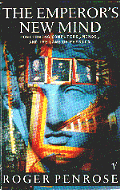 |
Chapter 9:Real Brains and Model Brains |
Blindsight
The split brain experiments seem at least to indicate that there need not
be a unique "seat of consciousness". But there are other experiments which
appear to suggest that some parts of the cerebral cortex are more to be
associated with consciousness than are others.One of these has to do with
the phenomenon of blindsight. Damage to a region
of the visual cortex can cause blindness in the corresponding field of vision.If
an object is held in that region of the visual field,then that object will
not be perceived.Blindness occurs with respect to that region of vision.
However,some curious findings (cf.Weiscrantz 1987) indicate that things are
not so simple as this.A patient,referred to as "D.B." had to have some of
his visual cortex removed,and this caused him to be unable to see anything
in a certain region of the visual field.However,when something was placed
in this region and D.B. was asked to guess what that something was (usually
a mark like a cross or circle,or a line segment tilted at some angle),he
found he could do so with near 100 per cent accuracy! The accuracy of these
"guesses" came as a surprise to D.B. himself,and he still maintained that
he could perceive nothing whatever in that region*.
Images received by the retina are also processed in certain regions of the
brain other than just the visual cortex,one of the more obscure regions involved
lying in the lower temporal lobe. It seems that D.B. may have been basing
his "guesses" on information gained by this lower temporal
region.Nothing was directly perceived consciously by the activation of
these regions.
All this seems to show that some areas of the cerebral
cortex (eg the visual cortex) are more associated with conscious perception
than are other areas,but that with training,some of these other areas can
apparently be brought within the scope of direct awareness.
* Somewhat complementary to blindsight is a condition known as "blindness
denial" according to which a subject who is in fact totally blind insists
on being able to see quite well, seeming to be visually conscious of the
inferred surroundings! (See Churchland 1984 p143)
| Descartes may have thought his consciousness was a unity,but
neurologists today would not agree.There is,they say,no more graphic evidence
of the way consciousness is "assembled" from different neuronal processes
than the bizarre way that brain injuries can tear them apart. Perhaps the
most startling of all is "blindsight"[Ref:[Maths 3] R.Penrose "ENM" p499
{blindsight};[Maths 3] enm9;Audio:FUJIc6017A"Do Elephants Weep?"3;Protext
Files {SN};Frontiers3.rtf],which violates our
common-sense view of consciousness.Here,damage to areas of the primary visual
cortex removes all sensation of light and colour from corresponding areas
of the visual field.Patients with this damage appear totally blind in one
part of the visual field.If asked whether they can see an object in this
area, the answer,obviously enough,is no. But,astonishingly,if the patients
are forced to guess where this object they cannot see is located,they often
point at it quite accurately.[How often,and how accurately?-LB] Although
they have lost all conscious sensation of "seeing",at some level they are
still able to see. "Consciousness" and the brain's information processing
thus appear split. What can it be like to have blindsight? Most patients simply say they are totally blind and cannot understand why experimenters ask them to "guess" where objects are when it is obviously pointless.But Larry Weiskrantz from the University of Oxford,who coined the term blindsight,has described how a few can have a mysterious feeling of awareness under the right circumstances."It's a sense that I haven't got,if that makes sense," was how one patient explained it. Blindsight is possible,the neurologists assume,because the visual pathway split into many parallel streams as it approaches the cortex and some streams go on to different parts of the brain,bypassing the primary visual cortex.Although these parts of the brain cannot create visual consciousness,they can provide some unconscious information to guide behaviour.Blindsight can thus give clues as to which parts of the brain are essential to generate consciousness. Damage even higher in the visual system or in the prefontal cortex - where the planning of behaviour takes place and links to motor output are made - creates even more bizarre problems,Lesions may not so much remove consciousness as strip away some of its attributes. The conscious vision of patients with damage in the extrastriate cortex may lack may lack one or more qualities:the patients can "see" but they may not be able to detect colour or movement.In philosophers' jargon,they have lost one or more "qualia" [Ref: R.Penrose "ENM" {qualia}] which populate the conscious sensory world. Some damage within the extrastriate cortex may leave the patient able to sense a full repertoire of qualia but destroy the ability to bind them together to perceive a whole object.This is called aperceptive agnosia. Such patients," says Peter Stoerig from the Institute of Medical Psychology in Munich,"may have normal visual fields,normal acuity,normal brightness discrimination,normal colour vision, normal motion processing ,but still they are unable to form an object out of these impressions." If they are shown a triangle,for example,they can see it but they cannot connect it with other geometric objects such as a circle or square.If they try to make drawings of objects,they can produce only meaningless scribbles. Defects elsewhere in the extrastriate cortex can rob consciousness of more of its normal qualities.To recognise,as well as see,an object,you must be able to create a web of associations around it by naming it and recalling things about it.These processes are destroyed in patients suffering from associative agnosia.They can see objects and make drawings of them perfectly well,but they cannot recognise the objects,nor say what they do,explains Stoerig. Even stranger is the world of people suffering from anosognosia.The condition occasionally occurs after stroke damage to the right side of the brain which leaves the patient paralysed on the left side of the body.Despite their obvious paralysis, however,anosognosics claim that their useless limbs work perfectly well. [New Scientist] |
